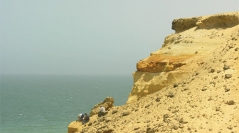

 Comptes Rendus Palevol
13 (7) - Pages 599-610
Comptes Rendus Palevol
13 (7) - Pages 599-610The Samlat Formation is well exposed in coastal sections bordering the Atlantic Ocean south of Ad-Dakhla in southwestern Morocco. Here some 22 m of rhythmically-bedded, chert-rich, marine siltstones and marls are overlain by 1–1.5 m of vertebrate-bearing microconglomeratic sandstone, another 4–8 m of rhythmically-bedded siltstone and marl, and finally a second 3–6 m unit of vertebrate-bearing muddy sandstone. The microconglomeratic and muddy sandstones represent low sea stands in what is otherwise a deeper water sequence. Cetacean skeletons are rare but cetacean vertebrae are common in the lower sandstone (bed B1), where many show the effects of reworking. The cetaceans in bed B1represent a minimum of five species, from smallest to largest: cf. Saghacetus sp., cf. Stromerius sp., Dorudon atrox, cf. Dorudon sp., and Basilosaurus isis. Bed B1 yields rib fragments that may represent sirenians, but sirenians, if present, are rare. The only identifiable cetacean found in the upper sandstone (bed B2) is Basilosaurus sp. Dugongid sirenians identified as cf. Eosiren sp. are the most common mammal in bed B2. We interpret co-occurrence of the typically Early Priabonian species Dorudon atrox and Basilosaurus isis with smaller species more like Middle Priabonian genera Saghacetus osiris and Stromerius nidensis to indicate that bed B1 was deposited during low sea stand Pr-2 between the Early and Middle Priabonian (between the early and middle Late Eocene). Bed B2 is separated from B1 by an interval of deeper water sediment accumulation. Bed B2 could represent a later phase of Pr-2 or a subsequent Priabonian low sea stand (possibly Pr-3).
Cetacea, Archaeoceti, Sirenia, Dugongidae, Late Eocene, Ad-Dakhla, Morocco